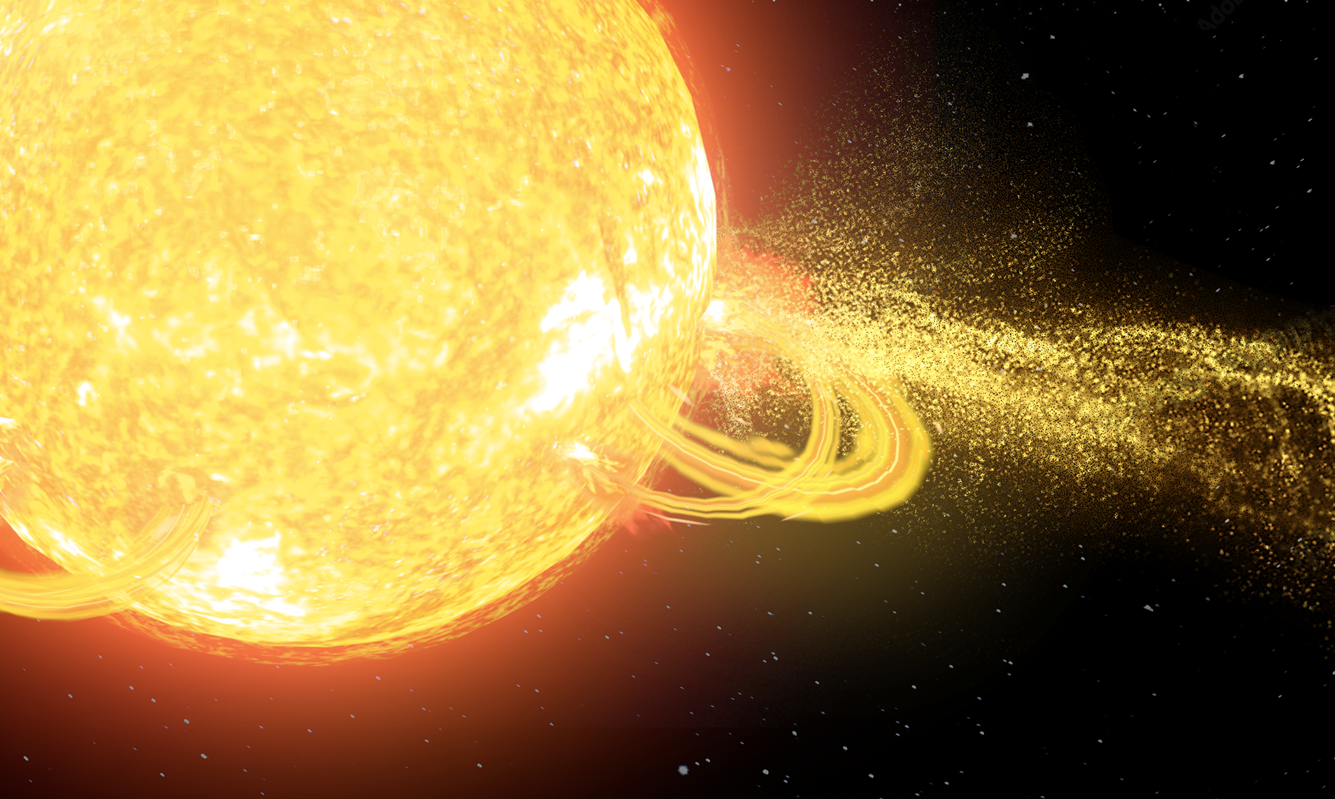Solar tornadoes: New findings reveal hidden twists in solar storms that threaten Earth
New simulations show hidden magnetic tornadoes in solar storms that can disrupt satellites and power grids on Earth.

Tornado-like magnetic spirals hidden inside solar eruptions offer a path to better space weather forecasts and earlier warnings for Earth. (CREDIT: The Astrophysical Journal)
A new University of Michigan study offers one of the most detailed pictures so far of how violent sun storms spread across space — and occasionally, straight to our planet. With the help of supercomputer simulations, researchers traced the birth and evolution of coronal mass ejections, or CMEs, and showed how these scorching bursts of material wind themselves into magnetic spirals like tornadoes that can shake Earth's magnetic field.
These solar storms are serious. They can incinerate satellite electronics, disrupt airplane navigation, and even wrap around power grids. One geomagnetic storm in May 2024 sent satellites off course and knocked out GPS systems farmers used, costing some Midwest operations thousands of dollars. The discovery by the Michigan scientists could keep future storms from surprising Earth.
Hidden Twisters in Solar Storms
CMEs are massive bubbles of electrically charged gas expelled from the Sun when it is most active. When they burst, they contain wrapped-around magnetic fields stretching out for millions of miles. But fresh high-resolution computer simulations reveal that CMEs are not just straightforward bubbles of plasma long thought to be the case — they cover a knotted mess of magnetic "flux ropes," tightly coiled loops that behave like cosmic tornadoes.
Our simulation shows that in such vortices the magnetic field is strong enough to cause a geomagnetic storm and some real problems," said William "Chip" Manchester, research professor of climate and space sciences and engineering and senior author of the research study.
Manchester's team mimicked a real solar outburst in 2014, one of the most spectacular of the decade. Hidden beneath its brilliant loops of light, the team found a chaotic inner universe where magnetic lines wrapped around each other, came unraveled, and re-threaded — an effect known as magnetic reconnection. This constant re-shuffling produced small, spinning magnetic knots inside the larger CME, each with its own punch.
A Model That Traces the Mayhem
To map these unseen forces, the team used a model based on physics called the Alfvén Wave Solar Atmosphere Model. Using it, they were able to map energy from the Sun's surface into the solar wind — the never-ending stream of particles blowing through the solar system. When the virtual explosion collided with slower-moving solar wind, the impact released a tempest of magnetic turns and twists.
These little storms quickly dissipated in some of them, but others persisted unbroken across millions of miles, coalescing into a cluster of stable magnetic whirlpools. These structures, the scientists found, are capable of trapping charged particles and boosting local magnetic fields in much the same way weather fronts collide in Earth's atmosphere.
Earlier models just took CMEs to be basic, balloon-shaped clouds. But this latest research shows they're more akin to untidy skeins of yarn, packed with tiny storms which can change the overall impact once they reach Earth.
Why These Twists Matter
Flux ropes are a seemingly minor detail, but they're the key to unlocking how solar storms affect the Earth. When a magnetic knot happens to be pointing south — in the opposite direction of Earth's magnetic field — it can produce a doorway for energy to pour into our magnetosphere. The outcome might be spectacular auroras or crippling spikes in electricity grids.
Because a lot of these hidden structures form away from the Sun, telescopes can't detect them coming. "If threats are forming out in space between the sun and Earth, we can't just look at the sun," said co-author Mojtaba Akhavan-Tafti, associate research scientist of climate and space sciences and engineering. "We have to actively look for structures such as these Earth-based flux ropes."
This morning's warning systems employ single satellites in fixed orbits between the Earth and the Sun. These satellites have only a point sample of solar wind and give an incomplete representation. "Imagine being able to track a hurricane using a single wind gauge," Manchester said. "You'd detect a change in the reading, but you'd have no idea what the shape or the direction of the hurricane was."
A Constellation to Catch Solar Tornadoes
To fill in that blind spot, the team suggests a new generation of spacecraft referred to as the Space Weather Investigation Frontier, or SWIFT. Four probes would fly in a pyramid configuration approximately 200,000 miles apart and simultaneously monitor the magnetic field and plasma as CMEs travel through space.
This three-dimensional view would allow researchers to map solar storms in three dimensions, track their evolving magnetic twists, and predict their impacts before they reach Earth. The central hub of the constellation would be located slightly closer to the Sun than current warning satellites — a location that would provide warnings as much as 40% sooner.
Keeping hub steady is a challenge. It would need a constant pushing off the gravity of the Sun, but engineers have found a solution: a shiny aluminum sail measuring about one-third the area of a football field. Developed through NASA's Solar Cruiser mission, the sail would use sunlight itself as a form of propulsion, enabling the space telescope to "park" in place without burning fuel.
Bridging the Gap Between Models and Reality
What makes this research stand out is how it brings closely detailed physics simulations together with real spacecraft measurements. Earlier missions such as Solar Orbiter and BepiColombo have already observed weaker flux ropes wandering through interplanetary space, in line with the trends the Michigan model predicts.
The researchers' work also explains why spacecraft sometimes register confounding magnetic flips and jolts of energy as a CME passes by. Those confusing readings are possibly not chaotic turbulence but observations of these mesoscale structures passing by the instruments — hidden storms in the storm.
By simulating these effects, the simulation crosses the theoretical-observational divide, presenting researchers with a clearer vision of what's actually taking place in the Sun-Earth turbulence layered region.
A Better Forecast for a High-Tech World
Understand the actual shape of solar storms is not simply an academic curiosity. Contemporary civilization depends on sophisticated systems that can be disturbed by a single extreme geomagnetic event. Power transmission grids, air routes for airliners, GPS, and communications all rely on unambiguous signals that space weather can mess up.
With more satellites and electric aircraft on the drawing board — and more ambitious plans for missions to the moon and Mars — predicting space weather is as crucial as predicting hurricanes.
The discovery that flux ropes can appear halfway to Earth accounts for why some solar flares cause havoc and others barely register. It also gives scientists a road map for building improved, quicker warnings.
Practical Implications of the Research
The study pushes space weather science to a new era of precision. In demonstrating that solar eruptions evolve into complex, spinning structures, the research sets the stage for faster, more accurate predictions. If such missions as SWIFT become a reality, grid managers, airlines, and satellite companies might be alerted in advance — protecting billions of dollars of assets and avoiding outages in service.
More broadly, understanding how such "solar tornadoes" form could shed more light on the physics of plasma throughout the universe. From fusion reactors to planetary magnetospheres, the same principles govern magnetic energy flow and evolution.
With the Sun nearing another peak phase of its 11-year cycle, such insight could be the difference between a breathtaking aurora display or a blackout.
Research findings are available online in The Astrophysical Journal.
Related Stories
- The most powerful solar telescope on Earth reveals forces that drive solar storms
- Solar Orbiter traces space-weather particles back to solar flares and CMEs
- New X-ray scans track violent solar winds threatening Earth’s satellites
Like these kind of feel good stories? Get The Brighter Side of News' newsletter.
Joseph Shavit
Science News Writer, Editor-At-Large and Publisher
Joseph Shavit, based in Los Angeles, is a seasoned science journalist, editor and co-founder of The Brighter Side of News, where he transforms complex discoveries into clear, engaging stories for general readers. With experience at major media groups like Times Mirror and Tribune, he writes with both authority and curiosity. His work spans astronomy, physics, quantum mechanics, climate change, artificial intelligence, health, and medicine. Known for linking breakthroughs to real-world markets, he highlights how research transitions into products and industries that shape daily life.



